What would your lawn look like if it was riddled with brown patches and bare spots all over? It wouldn’t just be terrible to walk on, but it would also make a horrible first impression on your always nitpicking neighbors. So, if your grass isn’t looking as good as it should, it might be in need of some fresh air. LITERALLY!Aerating increases the capacity of the soil to retain water and gives your grassroots better access to air. In addition, it is an excellent way of resolving soil compaction and drainage issues. However, when aerating a lawn, people are often divided on which aerator they should use — Spike Vs Plug Aerator ?
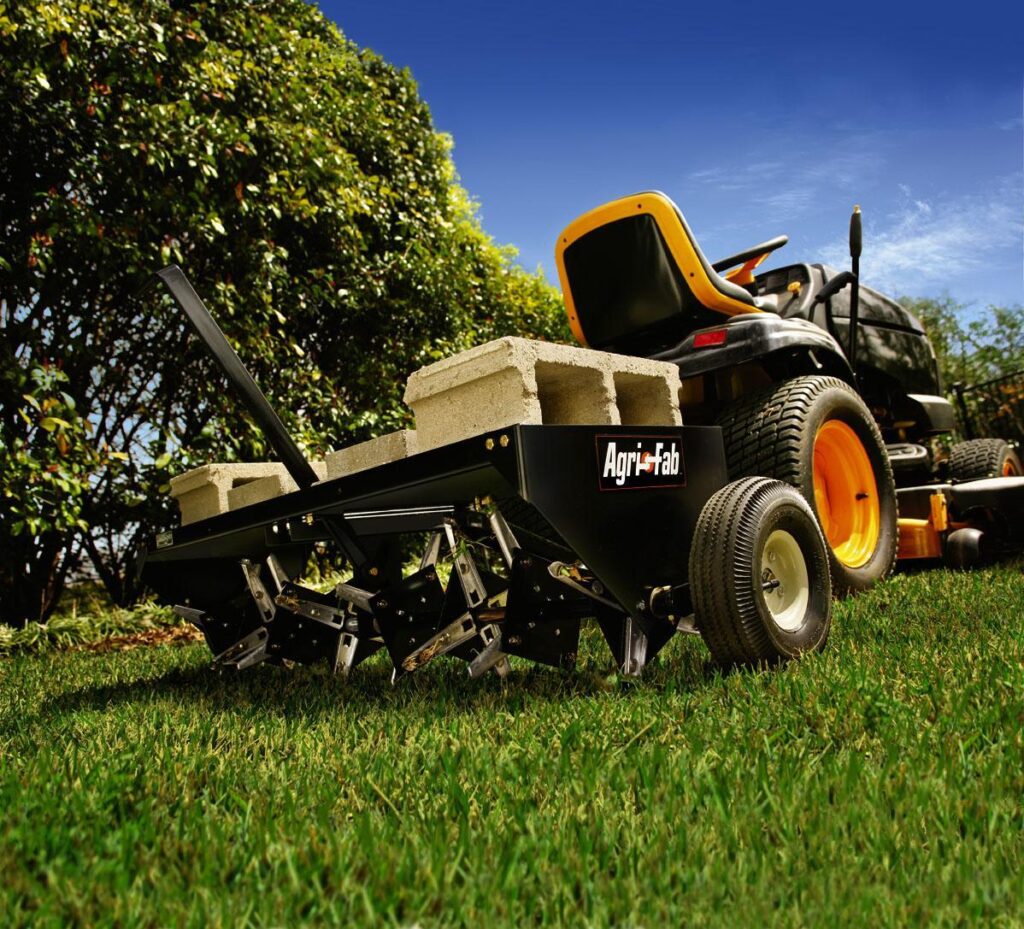
The spike aerator is equipped with pointed tines that pierce the soil to create tiny holes, thus aerating the lawn; in contrast, a plug aerator is equipped with hollow tines which penetrate the soil and remove soil plugs. In general, spike aerators should be used for small to medium lawns with moderate compaction issues, whereas plug aerators should be used for large lawns with severe compaction problems.
That said, you can also use plus aerators in small yards with severe compaction issues or if you have not aerated your lawn for quite a few years.
Read on to learn more!
Spike Vs. Plug Aerator | Differences
A quick comparison between plug and spike aerators is shown in the table given below:
| Plug Aerator | Spike Aerator |
|---|---|
| Plug aerators use hollow tines that remove plugs of compacted soil when pushed into the ground. | A Spike aerator is equipped with sharp spikes that infiltrate the ground. |
| Since dirt plugs are removed, this technique provides long-term decompaction. | Since no soil is being taken out, it offers temporary soil decompaction. |
Now that you know the main difference between plug and spike aerators let’s discuss which type of aerator you should use in your yard.
What Is Better, Plug Or Spike Aerator?
The ideal choice between plug and spike aerator depends on many variables—for instance, lawn size, foot traffic, budget, and the desired outcome.
Lawn Size

Lawn size is arguably the most important determinant of which type of aerator needs to be used. It is because large lawns usually suffer from more severe compaction issues that will be harder to resolve using a simple spike aerator.
On the other hand, small lawns are usually less prone to the harmful effects of foot traffic and generally do not suffer from severe compaction issues. So, there is no need to use a plug aerator here if there are no severe compaction problems.
Plug aeration is a technique that is frequently utilized on sports fields, such as tennis courts, golf courses, and football fields, as these cases generally see a high volume of foot traffic. Whereas spike aeration is primarily used in home settings
RELATED: Aeration & Overseeding For Lawns: Is It Worth It? A Comprehensive Guide
Amount Of Foot Traffic
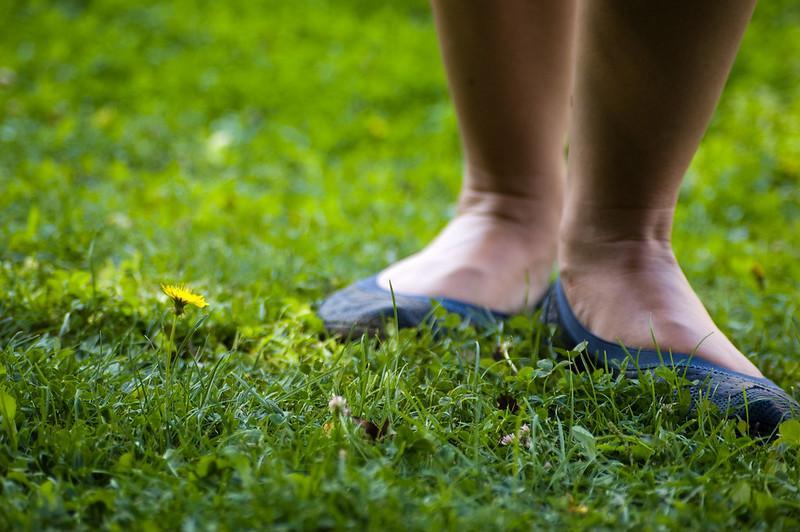
Lawns, even small ones, if they receive a lot of foot traffic, will over time get compacted, which can create a plethora of problems for the grass.
So, it is best to use a plug aerator on such lawns. It will not only relieve the soil compaction issues immediately but also prevent them from returning for quite a while.
On the other hand, lawns that do not see much traffic could do just fine with spike aerators, even if they are quite large.
Budget

Spike aeration is a cost-effective alternative to plug aeration if you are on a tight budget. Even if you need to core aerate your lawn, you do not have to buy a plug aerator; these machines can be rented as well.
However, if your work involves dealing with severe compaction issues or aerating large lawns, it is probably better to get a plug aerator.
Desired Outcome
The outcomes produced by spike and plug aerators also vary from each other. For instance, if you want to core aerate your lawn, use a plug aerator. It will remove plugs of soil from the ground and prevent compaction issues from returning for quite a while.
Spike & Plug Aerator | Pros & Cons
To sum up, here are the pros and cons of using a plug vs. spike aerator.
| Pros | Cons | |
|---|---|---|
| Spike Aerator | Effective for small lawns Relatively inexpensive Less messy | Not effective against severe compaction Time-consuming Labor intensive |
| Plug Aerator | Provides long-term solution Plugs removed decompose on soil and add nutrients to the soil Works well against severe compaction | Messy; plugs left behind Relatively expensive Holes left can encourage weed growth |
Now that you understand the basics of plug vs. spike aerators. Let’s talk about it in detail.
Plug Aerator

One way to alleviate the pressure that has built up under your lawn is to loosen the soil by plug aeration. The process of plug aeration involves removing small plugs of dirt from your yard and replacing them with cylindrical holes. This releases the pressure on the lawn and gives the remaining soil the opportunity to spread out.
How Effective Is Plug Aeration?
Plug aeration is a highly efficient method for reducing the tightness in the soil. In fact, plug aeration is so efficient that it is frequently employed in situations with extreme soil compaction. However, since plug aeration requires more work and specialized equipment, it is not often used on mild compaction or for regular day-to-day lawn maintenance.
When To Plug Aerate A Lawn?
Several factors determine the ideal time to plug aerate a lawn, including grass type and weather. For instance, the best time to plug aerate cool-season grasses is in the fall. Whereas warm-season grasses should be aerated from late spring to early summer.
As a general rule, aerate the grass right before its peak growing season. It is because plug aeration is somewhat a stressful procedure. So, it should be done at a time when the grass is in the best position to recover from the stress.
Avoid aerating when there is a drought or when the grass is dormant. Aerating your soil once a year is crucial if it is more clay-like, compacted, and subject to heavy foot traffic. Aeration for most other lawns is more than enough every two to three years.
Types Of Plug Aerators
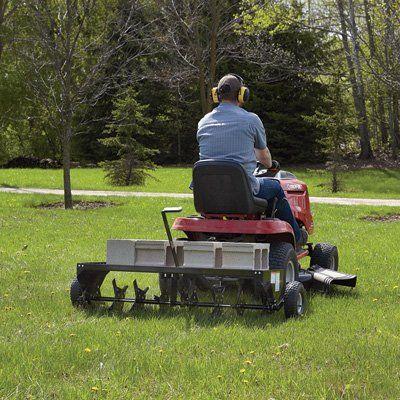
Tow-Behind Plug Aerators
A tow-behind (sometimes called a pull-behind) plug aerator is a simple method for core aeration if you have a lawn tractor. Although expensive, they will help you save time and effort. Also, when buying or renting, make sure that the tow-behind plug aerator has a weight tray to allow the tines to perforate the ground thoroughly.
Gas-Powered Plug Aerators
The most popular choice among homeowners is a push-behind, gas-powered core aerator that resembles a lawnmower. You should “mow” your grass with this aerator at least twice, the first time in one direction and the second time in the opposite direction.
Manual Plug Aerators
A manual plug aerator is a low-cost alternative for small yards. It’s also an excellent alternative for spot aeration if you only have a couple of compacted areas in your yard. It works by a person pushing the manual plug aerator into the ground with his foot to apply weight, and the plugs come out of the tines.
Comparison Between Various Types Of Plug Aerators
| Type Of Plug Aerator | Best For | Price | Rental Cost (Full Day) |
|---|---|---|---|
| Tow-Behind Plug Aerators | Larger lawns with a moderate to severe compaction | $100 to $300 | $50 |
| Gas-Powered Plug Aerators | Medium to large lawns with moderate to high compaction | $2,000 to over $5,000 | $100 |
| Manual Plug Aerators | Small lawns with mild to moderate soil compaction Or spot aeration | $30 to $125 | Not available for rent usually |
Spike Aerators
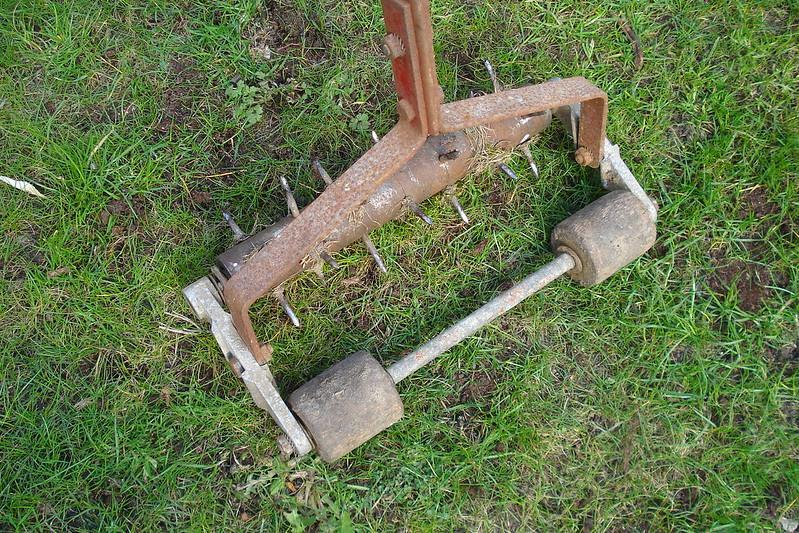
In essence, spike aeration is core aeration without the hollow cores. If core aeration resembles using a hole punch on paper, spike aeration resembles cutting through the paper with the tips of scissors. No soil is taken out when you spike aerate. Instead, dirt is pressed around the entire perimeter of the solid tine.
In the short run, spike aeration relieves compaction by loosening the soil, but over time, it causes compaction to increase.
Does Spike Aeration Really Work?
Since the spike aerator forces soil to the sides and down rather than removing the densely packed thatch and dirt that is causing soil compaction, spike aeration works but only provides temporary results. The little holes you create will eventually close when the soil readjusts. In addition, the tiny holes don’t lessen core compaction; on the contrary, they exacerbate it deep underground as time passes by.
How Often Can You Spike Aerate A Lawn?
Since the results do not last very long, it is preferable to aerate the lawn with a spike aerator two to three times per season. On the other hand, if you have aerated your lawn even just one time in the previous two seasons using a plug aerator, you should only spike-aerate your lawn once every season.
Pro Tip: Always check the amount of thatch at least twice a season to see if the layer is too thick and compacting the soil.
RELATED: Can I Mow Right After Aerating? | Mistakes That You Should Avoid!
Spike Aerators Types
Spiked Aerator Shoes
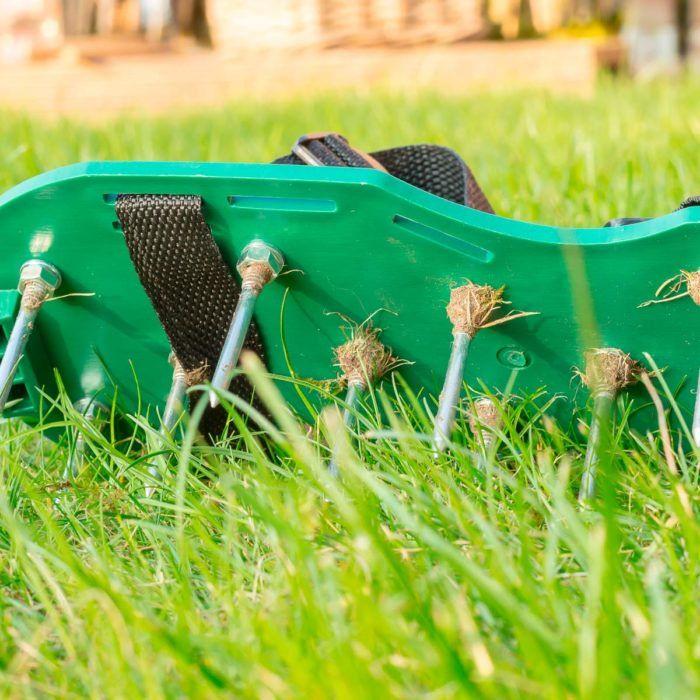
Basically, lawn aerator shoes are shoes with spikes. In theory, spike aerator shoes aerate the lawn as you walk about it while doing yard chores or when mowing the lawn. Spike shows only briefly alleviates the problems with soil compaction.
It is because the spikes on lawn aerator shoes are solid rather than hollow. So, when they penetrate the lawn, they push the dirt to the side and downward, further compacting the soil.
Handheld Aerators
Handheld aerators are often best suited for small lawns. They are available in a plug as well as a spike form. Landscapers are able to step onto the tool thanks to a sturdy foot platform and a dual-handle grip that is placed high on the tool to reduce back pain.
This allows them to drive the hollow tines or spikes repeatedly into the soil across the length of the lawn. Aeration using handheld aerator tools requires quite a bit of time and physical effort, but it is pretty effective at relieving compaction.
Push Aerators
Push aerators function best in constrained spaces, particularly those with tricky obstacles like playsets and trees. In addition, since these aerators typically contain spikes rather than hollow tines, they are better suited for lawns with moderate compaction.
Push aerators are more challenging to come by, and they need greater force to be pushed into the soil. So, choose a plug aerator that is either handled or pull-behind if you aim to loosen soil that has been compacted.
Mower Wheel Spikes
These are not very widespread; however, they are out there. They are attachments made to attach to the wheel of a lawn tractor or lawn mower, and they allow the operator to aerate the grass while cutting it.
The disadvantage of using mower wheel spikes is that they are pretty small and might not be able to create very deep holes. So, their use might not produce desirable results if your lawn is highly compacted.
Our Top Picks
If it appears that there is a lot of confusing information to sort through when looking for the ideal lawn aerator, the following list will help. It includes some of the top lawn aerators available on the market.
Agri-Fab Tow Plug Aerator
If you have a large yard or one with very compacted soil, a heavy-duty aerator like the one that Agri-Fab makes might be your best chance to break up the ground.
This tow-behind plug aerator has a path that is 48 inches wide, which aerates even the most enormous lawns very quickly.
It is also supported by a pair of flat-free 9.75-inch tires that allow it to traverse uneven terrain, and it includes a transportation lever that raises the knives so that they are out of the way of sidewalks and driveways.
Agri-Fab Spike Aerator
The Agri-Fab Spike Aerator is something that should be considered by those who would instead spike their lawns rather than pull plugs out of them. It has a weight tray with a capacity of one hundred pounds and ten separate spikes designed to pierce compacted soil to improve the flow of air and water to the roots of the lawn.
Yard Butler Lawn Coring Aerator
Handheld aerators are available from Yard Butler in both spike and core (plug) styles. The plug variety features two tines capable of penetrating up to 8.5 centimeters. The spike aerator contains four spikes that are each 3 inches long.
Both types of aerators are made from strong steel, stand 37 inches tall, and weigh four pounds in the neighborhood. Each one features rubber padding on the footrest and handles to make it easier to push the aerating tool into the ground.
Frequently Asked Questions (FAQs)
Is a plugger the same as a core aerator?
The main distinction between lawn pluggers and aerators is how aeration is accomplished. Lawn aerators do not remove a plug of soil; in fact, the weight of the attachment can exacerbate the compaction around the hole by pushing the dirt away from the spike.
Can you spike-aerate too much?
It’s possible to over aerate a lawn if you do it too often. Aerating your grass is not something that should be done on a seasonal basis because it is only necessary about once every year. You may be able to go as long as every two to three years between aerating your lawn if it is healthy and growing well or if it has sandy soil with a thin texture.
How deep should you aerate your lawn?
Aeration holes usually are anywhere from 2 to 6 inches apart and have a depth of 1-6 inches. Some varieties of aerators penetrate the soil with solid spikes or tines without removing a plug (spiking). However, these aren’t as efficient as plug aerators because they can add to the overall compaction.
How long do aeration plugs last?
Depending on the climate, the state of the soil, the amount of watering, and the mowing frequency, the plugs will begin to decompose and dissolve after about two weeks. And as a result of this process, the lawn will receive additional nutrients.
Should I aerate or dethatch first?
It is best to dethatch your grass before aerating it. Your grass will benefit from increased air, nutrient, and water penetration into its root zone if you dethatch and aerate your lawn simultaneously.
Sources For Further Reading
Lawn Aeration and Overseeding – University of Illinois Extension Service
Getting Your Lawn Ready for Summer – Aeration – University of Nebraska Extension Service







